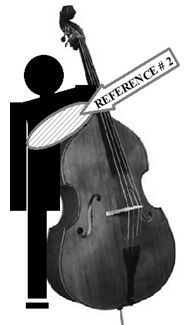Reference # 2 Torso to Sloped-Shoulders


When relating your body to the bass’s sloped- shoulders, always keep clearly in mind that you Never Slouch While Playing!
As you learned, the evolution of the shape of the bass has resulted in the sloped-shoulder design. Sloped-Shoulders, and narrow, Upper-Bouts, make it possible for you to always perform with excellent posture. Always strive to be grounded and comfortable!
Some professional players insist that the bass should remain free of contact with your legs, and others, insist that leg support helps to free the left hand and allows you to perform more fluid playing motions. Most professional players agree that you always must have leverage over your motions when performing. You use the weight of your body to gain dominance over the instrument, which gives you the power to perform with complete command.
Due to the size of the bass, it is extremely important to apply the concepts of weight in motion to you motions, resulting in comfortable and confident performances. (review weight in motion)
Regardless of your personal dimensions, the goal is to be set-up correctly, physically-centered behind the bass. This allows your arms to be free to travel the entire range of the instrument. The right side of the bass’s back should be close to your sternum, similar to the cello location.
Some players angle the bass so as to allow the right sloped- shoulder and part of the top right upper-bout rib to make gentle contact with your upper body. The reason is to minimize the distance between you and the playing areas that both of your hands make with the bass. Both of your arms always need to retain a free range of motion in order to play successfully.
The oval region in the diagram represents the general region that most players find comfortable, resulting in logical application of proper string playing principles.




